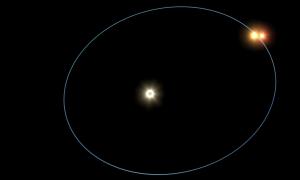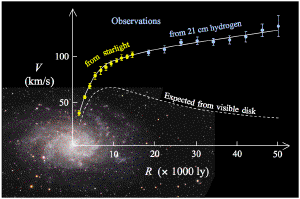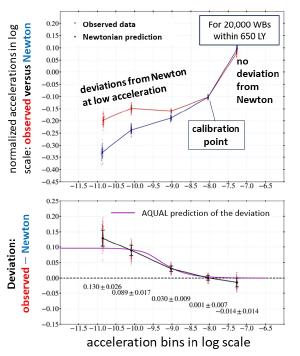Blog
AQUALity Result
11 August 2023
 NASA/JPL-Caltech
NASA/JPL-CaltechWith our continued failure to discover dark matter particles, it’s worth considering alternatives. While dark matter is the most widely supported model, the alternatives fall into two broad paths. One is that we should look to extended models of general relativity, such as conformal gravity. The other argues we should modify the very nature of Newtonian dynamics. The first approach tends to be popular with theorists since it focuses on an abstract theory in the same vein as Einstein’s original approach. The second, often known as Modified Newtonian Dynamics, or MoND, tends to be more popular with observational astronomers.
MoND has a long history in astronomy. It was first introduced back in the early 1980s by Mordehai Milgrom as a way to explain the rotation curves of galaxies. In our solar system, distant planets orbit the Sun at a slower pace than close planets, in excellent agreement with Newton’s Law of Universal Gravity. But stars in galaxies orbit the galactic center at roughly the same pace regardless of distance. The dark matter explanation is that most of the mass of a galaxy is distributed as a halo around a galaxy, we just can’t see it because dark matter doesn’t interact with light. MoND argues that Newton’s famous F = ma equation is only an approximation that works for larger forces. For extremely small forces, such as the galactic tug of gravity on a star, the acceleration deviates just enough to match the galactic rotation curve.
If this sounds like a cludge it kind of is. It violates fundamental physical laws, doesn’t play well with special relativity, and has lots of other problems. But it’s important to keep in mind it was originally proposed as a proof of concept, not a robust theory. So was dark matter in its early years.
 Mario De Leo
Mario De LeoOne of the reasons for MoND’s lack of popularity is that it isn’t a field theory. Electromagnetism, relativity, quantum theory, and others all treat physical quantities as fields, which allows physicists to apply all sorts of modern mathematical analysis. Since MoND isn’t a field theory, it lacks the kind of global structure that puts it on a level playing field, if you’ll pardon the pun. But there is a variant of MoND known as AQUAL, which stands for A QUAdratic Lagrangian. The predictions of AQUAL are slightly different from MoND, but AQUAL is a field theory, so it’s popular with dark matter contrarians. There is also a relativistic extension of AQUAL known as Tensor–vector–scalar gravity (TeVeS).
Although AQUAL isn’t popular in the scientific community, it is a valid testable model. Most of the predictions it makes are also made by dark matter models, but there are a few that differ. One of them is that the rotation curve of a galaxy should have a kink in it as the MoND effect becomes more dominant, and in 2022 this was seen in more than 100 galaxies. Now a study of binary stars seems to confirm AQUAL again.1
 Chae, Kyu-Hyun
Chae, Kyu-HyunRather than galaxies, this study looked at wide binaries. These are binary stars orbiting each other at large distances. Since the gravitational attraction between the stars is small, Newtonian gravity and AQUAL make slightly different predictions about their motion. And since dark matter doesn’t have a strong effect on the scale of star systems, it predicts the stars should follow Newtonian motion.
Taking data from the Gaia Space Telescope, the author analyzed the orbital motion of 26,500 wide-binary systems and compared the gravitational accelerations of the stars with their orbital separations. At larger accelerations, the orbits agree with both AQUAL and Newtonian gravity, but at smaller accelerations, the binary orbits deviate from Newton exactly as AQUAL predicts. In other words, for thousands of binary systems, AQUAL is a better model of their motion than Newton. This would seem to contradict dark matter models.
This is just one study, and the author is careful not to make bold claims. But it’s a very interesting result. Dark matter remains the better theory for things like galaxy clustering and gravitational lensing effects, but it seems clear AQUAL is a challenger that can’t be easily ignored.
Chae, Kyu-Hyun. “Breakdown of the Newton-Einstein Standard Gravity at Low Acceleration in Internal Dynamics of Wide Binary Stars.” The Astrophysical Journal 952 (2023): 128. ↩︎